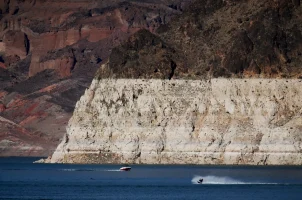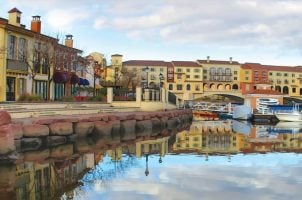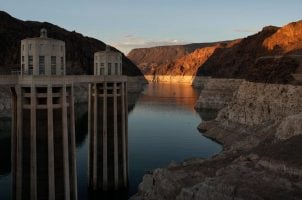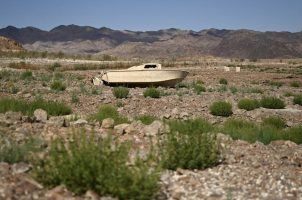VEGAS MYTHS RE-BUSTED: Las Vegas is in Imminent Danger of Running Out of Water
Posted on: August 11, 2023, 08:02h.
Last updated on: October 28, 2023, 07:54h.
EDITOR’S NOTE: “Vegas Myths Busted” publishes new entries every Monday, with a bonus Flashback Friday edition. Today’s entry in our ongoing series originally ran on Jan. 13, 2023.
Because of its proximity to Lake Mead, from which it gets 90% of its water, most people assume that Las Vegas is the main city threatened by the reservoir’s alarmingly dwindling water supply. In reality, its proximity to Lake Mead is what ensures Las Vegas its water supply for the foreseeable future.
As of December 17, Lake Mead was at 27% capacity, 1,043 feet above sea level. (This is not a measure of the water’s depth, by the way.) That’s its lowest level since 1937, when the reservoir was filled for the first time.
Yet, Las Vegas will be one of the last Southwestern cities reliant on Colorado River water to be in serious danger of running out of it.
Wet Republic
One of several reasons is the eight years of reserves Las Vegas has stockpiled for water emergencies. Some is stored in a groundwater aquifer where it was injected, and some is part of Lake Mead’s water. In comparison, in a snapshot estimate of its reserves in September 2022, the water authority in San Diego, which gets about half its supply from the Colorado River, said its local reservoirs held a six-month supply.
Some scenarios of climate change and water demand considered by the Southern Nevada Water Authority’s (SNWA) 50-year water resource plan require dipping into those reserves in the next couple of decades. However, not all scenarios do.
These massive reserves owe to Las Vegas being part of one of the world’s most efficient regions at water conservation. Since the current drought was first declared in 2002, Southern Nevada has never completely used its annual water allotment.
This is hardly the cumulative impression a tourist gets from observing the fountains at the Bellagio, Caesars Palace, and Wynn, in addition to all of those golf courses and aquariums that resort designers felt pressure to build over the decades to out-Vegas the competition.
The sum total of all the water used by resort hotels in Las Vegas amounts to only 6% of the total amount of Colorado River water used by the region, according to the SNWA. That’s because some of the Strip’s water, such as the Bellagio fountains’ supply, comes from private groundwater. It’s also because all of the water used indoors in Las Vegas gets recycled, treated, and returned to Lake Mead.
“You could literally go to every hotel room on the Strip, turn on every faucet, flush every toilet, and that’s not going to deplete from the amount of water that we withdraw from the Colorado,” SNWA spokesperson Corey Enus told Casino.org.
In addition, the SNWA, which treats and delivers water to 2.2 million people in Southern Nevada, and which acquires and manages long-term water resources, just imposed new, even stricter water restrictions, and has more in its pipeline. To meet its goal of reducing water use to 86 gallons per user per day by 2035, golf courses must use a third less water by 2024, and no new residential swimming pools can be built larger than 600 square feet.
Intaking Stock
The most significant step the SNWA took to insure a continually wet future occurred in 2017. That’s when it installed at Lake Mead a new deep water intake pipe (Intake No. 3) and pumping station at 860 feet above sea level. The first intake, installed in 1971, is no longer operable since it sits above the water line. A second intake was constructed at 1,000 feet in 2000, which is now just below the water’s surface.
According to a two-year projection by the federal Bureau of Reclamation, by the end of July 2024, Lake Mead’s water level could fall to as low as 992 feet above sea level, though the Bureau’s most recent five-year forecast gives virtually no chance that it could reach dead pool (895 feet) in the next five years.
Dead pool is when a reservoir is so low, gravity will no longer allow it to release water downstream. If and when Lake Mead hits this point, that will be dire news for downstream regions, including Los Angeles, Phoenix, San Diego, Tucson, and Mexico. Upstream regions, including Denver, Salt Lake City, and Albuquerque, won’t be affected at all. Bizarrely, Las Vegas will benefit from this situation, since any water that’s no longer released downstream will produce a tremendous conservation bump.
This is why SNWA hydrologists predict that Las Vegas will be able to draw Lake Mead water from its new intake for the foreseeable future.
There are 25 million people downstream of us in Arizona, California, and Mexico,” Enus said. “So, just strictly hydrologically speaking, once it gets to dead pool and we’re no longer able to release water downstream, we are still going to have access to our full allocation of that water because of the third intake and the low-lake-level pumping station.”
Busting this myth isn’t meant in any way to suggest that Las Vegas can’t ever run dry, or that California, Arizona, and Mexico running out of Colorado River water is somehow an acceptable situation.
“Water conservation is a journey and not a destination,” Enus said. “For the Colorado River Basin to continue, it is imperative that every single person in the basin continues to find ways to reduce water use now.”
Look for “Vegas Myths Busted” every Monday on Casino.org. Click here to read previously busted Vegas myths. Got a suggestion for a Vegas myth that needs busting? Email corey@casino.org.
Related News Articles
Nevada, Southwest Faces Unprecedented Water Restrictions
Most Popular
Mirage Las Vegas Demolition to Start Next Week, Atrium a Goner
Where All the Mirage Relics Will Go
Most Commented
-
Bally’s Facing Five Months of Daily Demolition for Chicago Casino
— June 18, 2024 — 12 Comments
















Last Comments ( 10 )
Stop building homes and populating the areas that use the water! I will never understand this. You bring more people they use more water. But, who cares right? As long as developers make money - it's not their problem in the future!
Enough debate on climate change. Our environment has to be made resilient for unpredictable weather. Going green doesn't mean going broke. Just commonsense as we want to leave a habitable world for the next generation. No need to argue on what is happening just work on reasonable solutions.
Climate Change is a thing, the fact that anyone can still refute this, in 2023, is mind boggling. 80% of the water used from the Colorado River is used on agriculture. Growing alfalfa and almonds in the middle of Arizona desert may not be the most effective use of such a limited and vital resource.
Global warming may not be so bad for the planet. Antarctica has 5.275 million square miles of frozen tundra,too cold for anything but penguins. The combined land space of USA, Mexico, Gt Britain, Italy, France & Germany is under 5 million square miles. Much of northern Canada, Greenland and northern Russia are also too frigid for most mammals.
I'm supposed to believe that my drip sprinklers are draining lake mead while vegas keeps spending millions of dollars building splash pads in the local parks, new car washes, strip casinos wasting billions of gallons of water? Scam. Wynn's golf course is the greenest, lush course in the world. What a joke
Climate change is such a scam. It is literally scamming taxpayers out of trillions of dollars. They say that CO2 is killing us. Ask any climate alarmist how much CO2 is in the atmosphere. They won’t know or will say something like too much. The is 0.04% CO2 in the atmosphere, anything less than 0.02%, plants begin to die. WAKE UP and WAKE SOMEONE ELSE UP. The first commenter is correct, waaaayyyy to many straw in the Colorado river, that is what is drying it up along with a Colorado river authority who throws water away. Research the pulse of life project, the salton sea agreements, etc. climate change, ha. Suckers
The Colorado river has been drying up for centuries. How do you think the grand canyon became so grand? The problem now is there's millions of more straws sucking out of it. We could fix the problem, but it's tough to get elected on a pro death platform.
Maybe they should stop building or severely restrict it. When I lived in Vegas in the eighties and nineties thre was virtually nothing between San Bernardino and Victorville. Victorville had a few truck stops and restaurants and the air force base then nothing to Barstow. Barstow had some fast food restaurants and some homes. Then there was nothing to Baker where there were a couple restaurants and gas stations. Then there was virtually nothing until the Nevada boarder where there was a prison and two casinos oh and a trailer park. After that there was nothing until you got to the old Hacienda hotel. Back then the southwest could handler a twenty year drought. Greed and uncontrolled growth has caused this problem more then the drought. Look at Salt Lake. The leaders know they are headed for a catastrophe yet the refuse to implement any major solutions they actually fine you for not watering your lawn or converting to desert landscaping
No Climate Change! The Earth does what it Wants,when it wants,can't control it , Million of years the changes have been happening deal with it.
Looking at Lake Mead and the low levels of the Mississippi River, man alone can not or will not change what nature is doing. Using lower amounts of water daily has to be a total operation, not just use at home. Companies use more water just to keep their landscape in 1 day then what most house holds use in a week. Fines for using more than you are allowed only affects those who cannot pay the fines but not others with expendable cash. I am glad I didn't move to Vegas like I wanted to 15 years ago. Worring about water is a way of life West of the Mississippi River and will only get worst as time goes by.